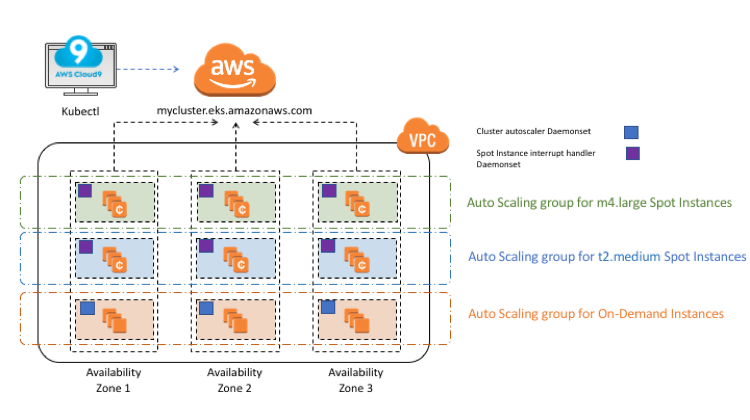AWS Compute Blog
Tag: Amazon EKS
Mixing AWS Graviton with x86 CPUs to optimize cost and resiliency using Amazon EKS
This post is written by Yahav Biran, Principal SA, and Yuval Dovrat, Israel Head Compute SA. This post shows you how to integrate AWS Graviton-based Amazon EC2 instances into an existing Amazon Elastic Kubernetes Service (Amazon EKS) environment running on x86-based Amazon EC2 instances. Customers use mixed-CPU architectures to enable their application to utilize a wide selection […]
Simplifying Amazon EC2 instance type flexibility with new attribute-based instance type selection features
This blog is written by Rajesh Kesaraju, Sr. Solution Architect, EC2-Flexible Compute and Peter Manastyrny, Sr. Product Manager, EC2. Today AWS is adding two new attributes for the attribute-based instance type selection (ABS) feature to make it even easier to create and manage instance type flexible configurations on Amazon EC2. The new network bandwidth attribute […]
Efficiently Scaling kOps clusters with Amazon EC2 Spot Instances
This post is written by Carlos Manzanedo Rueda, WW SA Leader for EC2 Spot, and Brandon Wagner, Senior Software Development Engineer for EC2. This post focuses on how you can leverage recently released tools to optimize your usage of Amazon EC2 Spot Instances on Kubernetes Operations (kOps) clusters. Spot Instances let you utilize unused capacity […]
Building Modern Applications with Amazon EKS on Amazon Outposts
This post is written by Brad Kirby, Principal Outposts Specialist, and Chris Lunsford, Senior Outposts SA. Customers are modernizing applications by deconstructing monolithic architectures and migrating application components into container–based, service-oriented, and microservices architectures. Modern applications improve scalability, reliability, and development efficiency by allowing services to be owned by smaller, more focused teams. This post […]
Best practices for handling EC2 Spot Instance interruptions
This post is contributed by Scott Horsfield – Sr. Specialist Solutions Architect, EC2 Spot Amazon EC2 Spot Instances are spare compute capacity in the AWS Cloud available to you at steep discounts compared to On-Demand Instance prices. The only difference between an On-Demand Instance and a Spot Instance is that a Spot Instance can be […]
Using AWS App Mesh with Fargate
This post is contributed by Tony Pujals | Senior Developer Advocate, AWS AWS App Mesh is a service mesh, which provides a framework to control and monitor services spanning multiple AWS compute environments. My previous post provided a walkthrough to get you started. In it, I showed deploying a simple microservice application to Amazon ECS […]
Scaling Kubernetes deployments with Amazon CloudWatch metrics
This post is contributed by Kwunhok Chan | Solutions Architect, AWS In an earlier post, AWS introduced Horizontal Pod Autoscaler and Kubernetes Metrics Server support for Amazon Elastic Kubernetes Service. These tools make it easy to scale your Kubernetes workloads managed by EKS in response to built-in metrics like CPU and memory. However, one common use case for applications […]
Learning AWS App Mesh
UPDATE – Oct 26 2020 – We have updated the instructions and recommended configurations for AWS App Mesh, which can be found in this GitHub repository: https://github.com/aws/aws-app-mesh-examples/tree/master/examples/apps/djapp. Please consider the below steps deprecated, but we are leaving the post live for its deeper explanation of some of the steps involved. This post is contributed by […]
Run your Kubernetes Workloads on Amazon EC2 Spot Instances with Amazon EKS
Contributed by Madhuri Peri, Sr. EC2 Spot Specialist SA, and Shawn OConnor, AWS Enterprise Solutions Architect Update – June 30, 2020: As we continue to improve how Amazon EKS and Spot Instances work together, best practices change. Please read this blog for the latest best practices on how to use Amazon EKS with Spot Instances. […]







